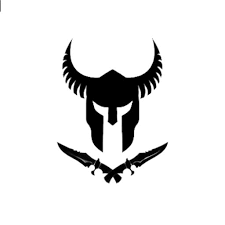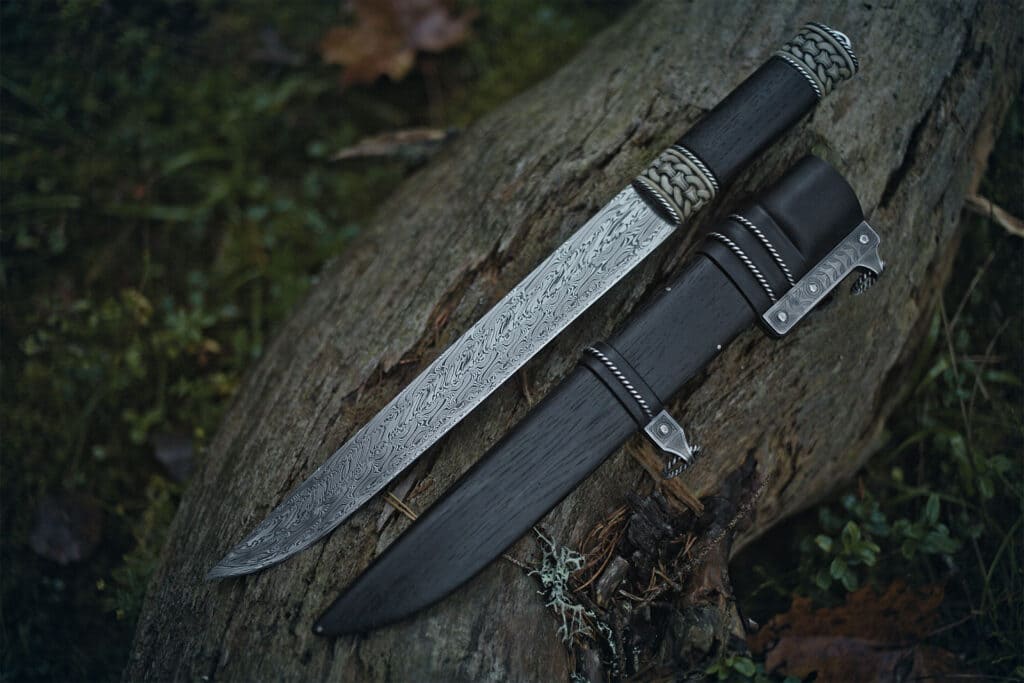What Is a Scramasaxe Knife ? What Does Scramasaxe Mean ? This Article Is the Answer to All Your Questions.
In this article, we will explore the fascinating history of the scramasaxe knife, its use, and its evolution over time. We will also examine the different features and variants of the scramasaxe, as well as the reasons it has become a coveted collectible item. So, if you’re interested in the history of knives or want to learn more about this fascinating tool, read on!
Summary
Toggle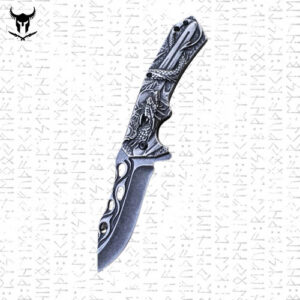
Nidhoggr Viking Folding Hunting Knife with High-Hardness Steel Handle
⚒️ A blade, a legacy — forge yours now.
Buy nowDefinition of Scramasaxe
The word scramasaxe is an ancient English word for a knife. The scramasaxe or seax itself was a small knife, sword, or dagger, and according to archaeological findings, it dates back to the early Middle Ages among Germanic peoples. The name strongly suggests that the Saxons named themselves as a people after the knife. The Viking Breitsax was versatile, and both women and men carried it in their daily activities. In fact, the knife served as both a tool and a weapon.
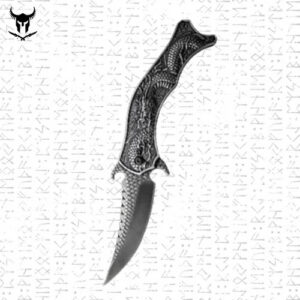
Níðhöggr's Folding Spring Survival Knife
⚒️ A blade, a legacy — forge yours now.
Buy nowThe Use of Scramasaxe Among the Vikings
Vikings led active lives, from farming to hunting to combat, and they needed a handmade hunting knife to assist them in all these endeavors. While Vikings are known for their axes in literature and media representations, they had other Viking cutting tools, one of which was the Seax, and the Scramasaxe.
The Scandinavian Scramasaxe is unique to the early Nordic peoples, including the Vikings. Both men and women carried it with them, whether they were going to the farm or to war. Here, we’ll explore the Nordic Schmalsax, giving you a better understanding of its appearance and typical use.

Nidhoggr Viking Folding Hunting Knife with High-Hardness Steel Handle
⚒️ A blade, a legacy — forge yours now.
Buy nowThe Scandinavian Scramasaxe in Norse Mythology
Some available sagas reference the Scramasaxe, although it goes by different names depending on its length. In some cases, it was called either the scramasaxe or the langsax, depending on its size. From translations, it is believed that the former name refers to the shorter “short seax,” and the latter to the longer seax, like the Danish scramsax.
However, most of the time, the name used to refer to the Viking Knife in the sagas was Viking sax.
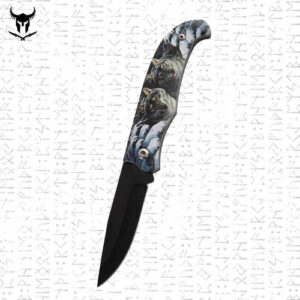
Viking Folding Knife Ragnar WOLF Compact and Efficient
⚒️ A blade, a legacy — forge yours now.
Buy nowWhat Does a Handcrafted Viking Scramasaxe Look Like ?
The appearance of the handcrafted Viking seax varied depending on the length and width of the expertly forged blade from the Viking forge. However, the basic shape remained the same. The langseax consisted of a curved sword with a serrated blade. It was large and had a single-edged blade. Generally, a tang ran down the center of the blade and inserted into an organic handle, made of wood or horn. When not in use, the Viking scramasaxe was placed in a sheath attached to the belt. Vikings, as a best practice, ensured that the edge of the blade was always facing upward.
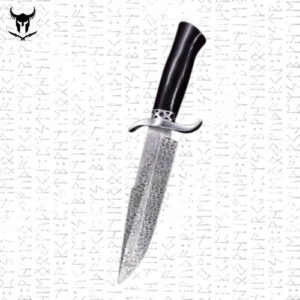
Viking Survival Dagger in Steel, Compact and Durable
⚒️ A blade, a legacy — forge yours now.
Buy nowThe Adaptation of the Viking Scramasaxe Over Time
Between 450 and 800 AD, scramasaxe knives evolved. The only constant was that each time, the back and the edge curved towards the tip. Let’s examine the different phases of the scramasaxe.
The Kurzsax
The first one, known as the kurzsax, had a long and narrow blade. The length of the Scramasaxe blade was generally about 22 inches, with the overall length reaching 28 inches. This means that the shorter end of the blade measured about 8 inches, while the longer side was approximately 12 inches.
The Beauty of a Viking Scramasaxe
The next seax was more elaborate. Blacksmiths hammered geometric patterns made of twisted silver, copper, or brass wire into grooves they had cut into the blade itself. Other shapes incorporated into the blades were triangles and diamonds, which had their own spiritual significance. Some curved blades found at Viking sites featured snakes engraved on the blade or braided bands. The pommels or guards were made of metal. The knife was known as the scramasaxe damascus.
The Schmalsax and the Breitsax
As time went on, the blades became wider and lighter and no longer had metal at the handle, initially called schmalsax, but after multiple modifications on the width, it is where the term “Breitsax” was created, which means wide seax.
During this time, decorations were simpler, with most blades featuring only parallel lines.
Langsax
Subsequently, the scramasaxe blade remained wide but, due to the metal used, it became heavier. Viking scramasaxes measured between 50 and 20 cm, and decorations on the blades were rarely present. It can be said that as scramasaxes evolved, they started as simple, highly decorated, and eventually became less elaborate.
What Was the Purpose of the Viking Scramasaxe ?
War was ever-present for the Vikings, so the scramasaxe was primarily a combat knife. According to findings, this forged scramasaxe was mainly used in the early Viking era, before their weaponry evolved to include axes and other short knives. While the knife is considered a short sword, it would be incorrect to think of it as anything less than a deadly weapon. Viking weapons were known for their exquisite craftsmanship, and this one is no exception. Even blades without intricate patterns were capable of taking down an enemy with ease.

Viking Folding Hunting Knife, inspired by the wolf, with a sharp blade.
⚒️ A blade, a legacy — forge yours now.
Buy nowWhat Role Did the Combat Scramasaxe Play in Viking Wars ?
When warriors roamed, their seaxes could be found carried in a sheath attached to the belt, suspended horizontally. As always, the blade’s edge was oriented upward in the sheath; this way, it couldn’t cut through it, as the blades were quite sharp. It was also common for the blades to vary in length to accommodate people’s overall physique and their ability to wield a weapon.
The length of the scramasaxe was useful, especially in close combat. It was small enough to be concealed behind the shield, which, according to warriors, provided an element of surprise. They could strike and stab the enemy without having to expose too much of their body, as they would have if they had used a large axe or sword. Warriors had to be careful in how they wielded the sword, as it was a single-edged blade. Although it wasn’t their weapon of choice in warfare, the seax was used if someone was cornered or had lost their axe in the field.

Nordic Folding Pocket Survival Knife for Outdoor Camping
⚒️ A blade, a legacy — forge yours now.
Buy nowDid the Scramasaxe Serve as a Utensil ?
While the Vikings are famous for their swords and axes, when it comes to weapons and similar items, Viking scramasaxes deserve special mention as tools used both in everyday life and in wars.
Just like axes, Viking knives were of great importance in daily life. Vikings lived on farms and had many occasions throughout their day to use well-sharpened knives.
One of the typical types of Viking knives was called the seax. It was used in daily life in various situations, from skinning animals to pulling and cutting turnips and other root vegetables.
On the other hand, the seax knife was a highly versatile weapon that was also used in warfare when the situation called for it.
There were different blade lengths, so some of these Viking knives resembled smaller swords. They needed to be precise, sturdy, and capable of meeting all the demands of Viking life.
Some of these Viking weapons, like the broken-back knife, are very popular in the revival of Viking culture and are often depicted in various TV series and movies depicting the Vikings and their way of life. This type of Viking knife was a bit heavier and was more commonly used as a weapon.
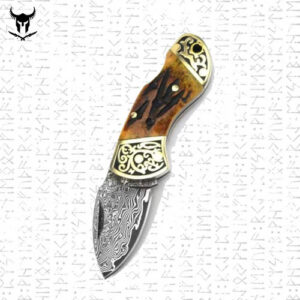
Folding Nordic Damascus Steel Knife with Hand-Carved Pure Brass Handle
⚒️ A blade, a legacy — forge yours now.
Buy nowForging a Scramasaxe Knife !
According to historical sources, scramasaxe knives were made by forming a stack of up to nine layers of iron plates with different carbon content. These layers were welded together, and more layers resulted in a better final result. In some cases, the rods formed during this process were forged in different directions to create a decorative pattern on the knife. This was the basic production process, which was later refined or modified over time.
The Combat Scramasaxe in Battles
As mentioned earlier, Viking knives were generally used as tools, and they were used by both women and men, regardless of age and social status.
Items found in graves in Scandinavian countries show that scramasaxe knives of this type were more commonly used in and for the burials of men, as this type of knife was used in battles.
However, this distinction is not very clear and should not be taken as such because Viking society did not have strict gender roles and could be considered somewhat egalitarian.
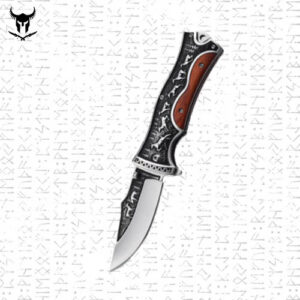
Engraved Folding Viking Pocket Knife for Outdoor Use
⚒️ A blade, a legacy — forge yours now.
Buy nowScramasaxe, a Viking Knife for Everyone !?
As the size of the scramasaxe was generally larger than that of a common Viking knife used in everyday life, it served as a mini-sword in a way. Owning a sword was a matter of prestige and not something all Vikings could have, so the short seax served this purpose when swords were not available.
Being lighter, a bit smaller, and therefore easier to handle, this type of Viking knife was also used as an additional weapon in close combat with the enemy or when the situation was unpredictable and quick action was required. Quick reactions were definitely easier to manage with a seax than with a heavy large sword.
The wealthiest members of Viking society used both the sword and the mini scramasaxe.
Over time, the general trend was that scramasaxe knives became longer and heavier.
As seen earlier, scramasaxes made in the late 7th century CE were the longest but somewhat lighter. According to some sources, this type of Viking knife appeared in Scandinavia starting from the 4th century CE.
Scramasaxes were spread to approximately all countries in Europe: like the Thames, and some Merovingian and Carolingian countries.
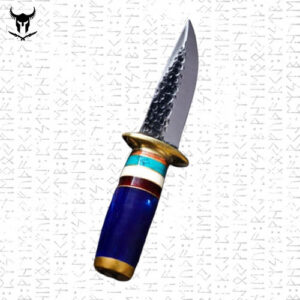
Survival Viking Knife | High Hardness Portable Puukko
⚒️ A blade, a legacy — forge yours now.
Buy nowHow Were Viking Knives Made ?
As a definition for the Scramasaxe Knife: it was one of the most popular and typical historical Viking scramasaxes. The word “skram” means “notch” coming from the Indo-European root, which was famous for their blades.
However, there were also other types of Viking knives, smaller ones. This type of knife was (and still is) known as the “scramasaxe dagger,” and another longer one known as the “scramasaxe sword.”
Scramasaxes in Northern Europe:
The scramasaxe was one of the most popular weapons in northern Europe. Many peoples from the early Middle Ages used the seax, including the Vikings, Merovingians, Carolingians, Anglo-Saxons (Thames), Germanic tribes, and Franks.
Originally, the scramasaxe was a utility knife, but it was taken into battle when a sword was not available. It became a full-fledged weapon.
Perfect for collectors and reenactments of the early Middle Ages.
Beagnoth’s Seax, also known as the Thames Scramasaxe It was found in the River Thames in 1857 and is currently exhibited at the British Museum. An Anglo-Saxon seax dating from the 10th century and found in the Thames. That’s why it is also called Thames Scramasaxe.
On one side of the blade is the only known complete inscription of the twenty-eight-letter Anglo-Saxon runic alphabet, as well as the name “Beagnoth” in runic letters. It is believed that the runic alphabet had a magical function, and the name Beagnoth is either the owner of the weapon or the blacksmith who forged it.

Engraved Folding Viking Pocket Knife for Outdoor Use
⚒️ A blade, a legacy — forge yours now.
Buy nowWhile many Anglo-Saxon and Viking swords and knives have Latin alphabet inscriptions on their blades or runic inscriptions on the handle or sheath, the Seax of Beagnoth is one of the few finds with a runic inscription on its blade.
Merovingian and Carolingian Scramasaxe
The seax was the weapon of choice for Germanic tribes from the early Middle Ages to the Viking era. There are many variants with different blade lengths: the Merovingian or Carolingian seax was used both as a tool and a weapon. Also known as the Frankish scramasaxe.
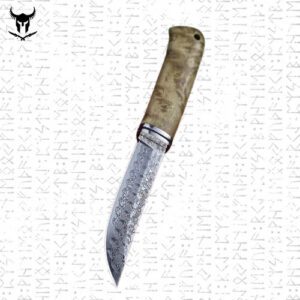
Lapon Hunting Knife Viking in Shade Wood and Damascus 22.5 CM
⚒️ A blade, a legacy — forge yours now.
Buy nowFrankish Scramasaxe
The ancient Franks, especially those living in Paris, learned to forge it during their confrontation with the Vikings. Even though they suffered many losses, they managed to benefit from it, unfortunately, they couldn’t learn their boat-building method.
